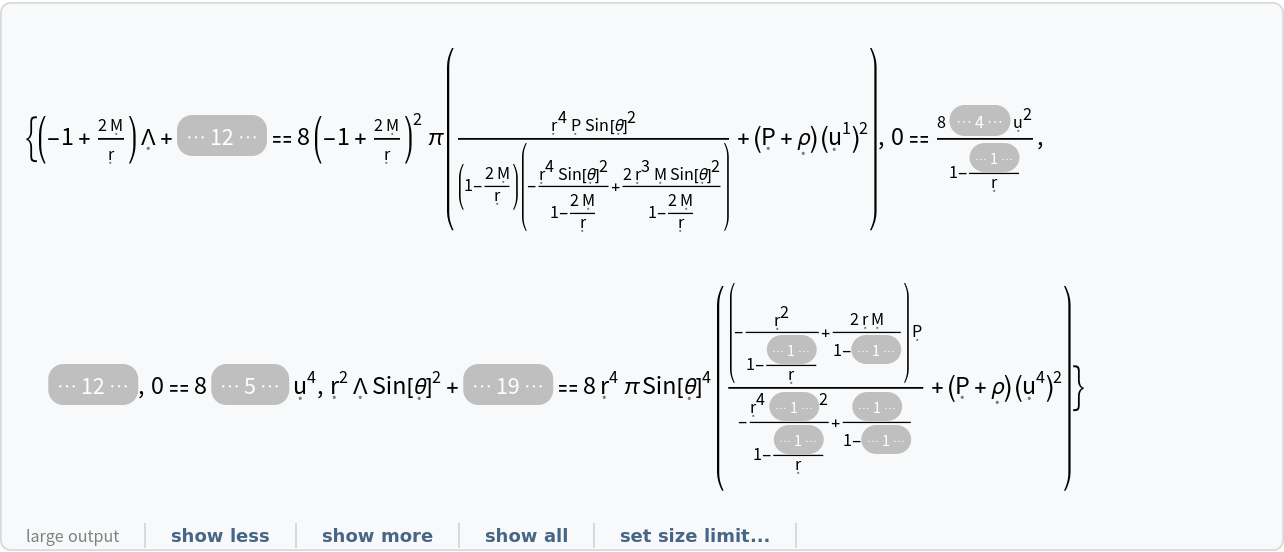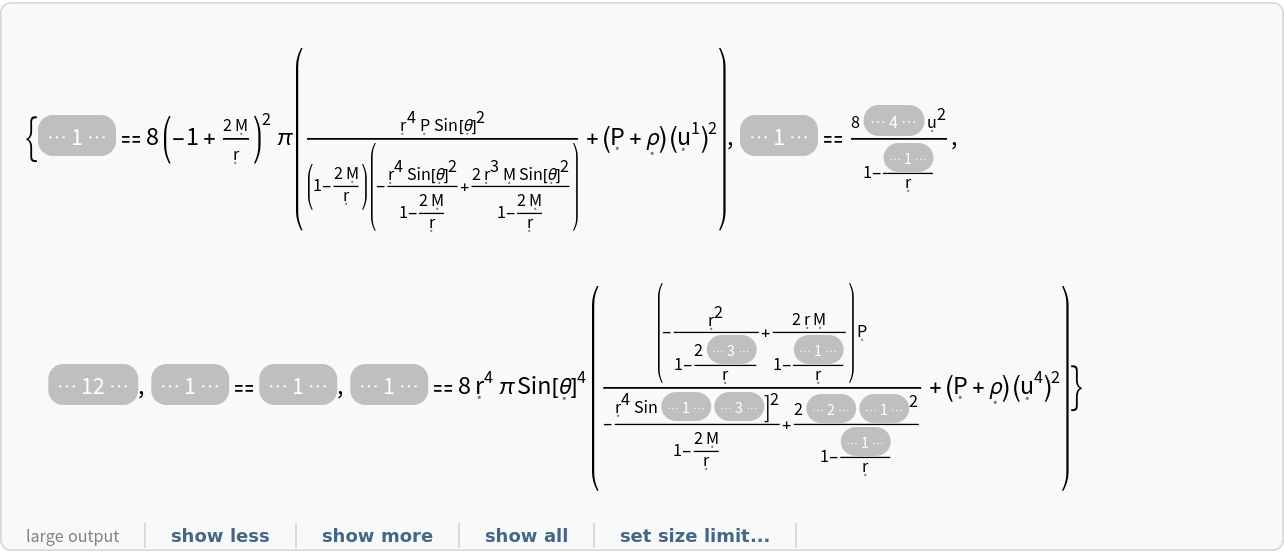Basic Examples (3)
Solve an Einstein equation system:
More specifically, show that a perfect and static relativistic fluid (with symbolic 4-velocity u, symbolic density and symbolic pressure P) is a valid solution to the Einstein field equations for the Friedmann-Lemaître-Robertson-Walker (FLRW) metric (for a homogeneous, isotropic and uniformly-expanding/contracting universe, with symbolic curvature parameter k and symbolic scale factor a) in standard spherical polar coordinates, with zero cosmological constant:
Show that the perfect and static relativistic fluid solution for the FLRW metric is not exact (i.e. additional field equations need to be assumed):
Show that the perfect and static relativistic fluid solution for the FLRW metric remains valid when assuming a non-zero (symbolic) cosmological constant :
Show the list of all continuity equations for a perfect and static relativistic fluid in the FLRW geometry, asserting that energy and momentum are conserved (i.e. the covariant divergence of the stress-energy tensor vanishes):
Show the list of all continuity equations for a perfect and static relativistic fluid in the FLRW geometry, asserting that energy and momentum are conserved (i.e. the covariant divergence of the stress-energy tensor vanishes), with all algebraic equivalences imposed:
Show that the perfect and static relativistic fluid solution for the FLRW metric remains valid when assuming a numerical 4-velocity {-1,0,0,0} (i.e. a vanishing fluid velocity):
Show list of all Einstein field equations, asserting that the Einstein curvature tensor for the FLRW geometry is equal to the stress-energy tensor for a perfect and static relativistic fluid (up to a multiplicative constant):
Show the list of all Einstein field equations, asserting that the Einstein curvature tensor for the FLRW geometry is equal to the stress-energy tensor for a perfect and static relativistic fluid (up to a multiplicative constant), with all algebraic equivalences imposed:
Show that a static relativistic radiation distribution (i.e. a static perfect fluid whose density is equal to three times its pressure) is also a valid solution to the Einstein field equations for the FLRW metric:
Show that a static relativistic dust (i.e. a static perfect fluid with symbolic 4-velocity u, symbolic density and vanishing pressure) is a valid solution to the Einstein field equations for the Gödel metric (for a rotating, dust-filled universe, with symbolic angular velocity ) in Gödel’s Cartesian-like coordinates, with zero cosmological constant:
Show that the static relativistic dust solution for the Gödel metric is not exact:
Show the list of all Einstein field equations asserting that the Einstein curvature tensor for the Gödel geometry is equal to the stress-energy tensor for a static relativistic dust (up to a multiplicative constant):
Show the list of all continuity equations for a static relativistic dust in the Gödel geometry, asserting that energy and momentum are conserved (i.e. the covariant divergence of the stress-energy tensor vanishes):
Show the list of all continuity equations for a static relativistic dust in the Gödel geometry, asserting that energy and momentum are conserved (i.e. the covariant divergence of the stress-energy tensor vanishes), with all algebraic equivalences imposed:
Show that the static relativistic dust solution for the Gödel metric remains valid when assuming a non-zero (symbolic) cosmological constant :
Show that a dynamic relativistic dust distribution (i.e. a dynamic perfect fluid with symbolic 4-velocity function u, symbolic density function and vanishing pressure) is also a valid solution to the Einstein field equations for the Gödel metric:
Show that a dynamic and source-free electromagnetic field (with electric scalar potential ϕ, vanishing magnetic vector potential and symbolic vacuum magnetic permeability constant 0) is a valid solution to the Einstein field equations for the Reissner-Nordström metric (for a charged, non-rotating black hole with symbolic mass M and symbolic electric charge Q) in standard spherical polar coordinates, with zero cosmological constant:
Show that the dynamic and source-free electromagnetic field solution for the Reissner-Nordström metric remains valid when assuming a non-zero (symbolic) cosmological constant :
Scope (3)
By default, SolveEinsteinEquations will solve the Einstein field equations in terms of the MetricTensor associated to the given StressEnergyTensor:
This default choice may be overridden using an additional argument:
By default, SolveEinsteinEquations will use a symbolic value () for the cosmological constant:
This default choice may be overridden using an additional argument:
The MetricTensor and cosmological constant arguments can be specified simultaneously:
Solve the full Einstein field equations for a perfect and static relativistic fluid (with symbolic 4-velocity u, symbolic density and symbolic pressure P) in the Schwarzschild metric, with symbolic mass M, and assuming symbolic cosmological constant :
Show the list of properties:
Show the list of (additional) field equations that must be assumed in order for the stress-energy tensor to be a valid solution to the full Einstein field equations:
Show the list of full Einstein field equations asserting that the Einstein curvature tensor (plus the metric tensor multiplied by the cosmological constant) is equal to the stress-energy tensor up to a multiplicative constant:
Show the list of full Einstein field equations asserting that the Einstein curvature tensor (plus the metric tensor multiplied by the cosmological constant) is equal to the stress-energy tensor up to a multiplicative constant, with all algebraic equivalences imposed:
Show the list of full Einstein field equations asserting that the Einstein curvature tensor (plus the metric tensor multiplied by the cosmological constant) is equal to the stress-energy tensor up to a multiplicative constant, with all partial derivative operators left purely symbolic:
Show the list of all continuity equations asserting that the covariant divergence of the stress-energy tensor must vanish (i.e. energy and momentum are conserved):
Show the list of all continuity equations asserting that the covariant divergence of the stress-energy tensor must vanish (i.e. energy and momentum are conserved), with all algebraic equivalences imposed:
Show the list of all continuity equations asserting that the covariant divergence of the stress-energy tensor must vanish (i.e. energy and momentum are conserved), with all partial derivative operators left purely symbolic:
Show the metric tensor for the underlying manifold represented by the solution of the full Einstein field equations:
Show the stress-energy tensor associated to the solution of the full Einstein field equations:
Show the list of coordinate symbols for the solution of the full Einstein field equations:
Show the list of differential 1-form symbols for the coordinates of the solution of the full Einstein field equations:
Determine whether the stress-energy tensor is a valid solution of the full Einstein field equations:
Determine whether the stress-energy tensor is a valid exact solution to the full Einstein field equations (i.e. no additional field equations need to be assumed):
Show the value of the cosmological constant for the solution of the full Einstein field equations:
Show the number of dimensions of the underlying manifold represented by the solution of the full Einstein field equations:
Show the signature of the underlying manifold represented by the solution of the full Einstein field equations (with +1s representing positive eigenvalues and -1s representing negative eigenvalues of the metric tensor):
Determine whether the underlying manifold represented by the solution of the full Einstein field equations is Riemannian (i.e. all eigenvalues of the metric tensor have the same sign):
Determine whether the underlying manifold represented by the solution of the full Einstein field equations is pseudo-Riemannian (i.e. all eigenvalues are non-zero, but not all have the same sign):
Determine whether the underlying manifold represented by the solution of the full Einstein field equations is Lorentzian (i.e. all eigenvalues of the metric tensor have the same sign, except for one eigenvalue which has the opposite sign):
Show the list of conditions on the coordinates required to guarantee that the underlying manifold represented by the solution of the full Einstein field equations is Riemannian (i.e. all eigenvalues of the metric tensor are positive):
Show the list of conditions on the coordinates required to guarantee that the underlying manifold represented by the solution of the full Einstein field equations is pseudo-Riemannian (i.e. all eigenvalues of the metric tensor are non-zero):
Show the list of conditions on the coordinates required to guarantee that the underlying manifold represented by the solution of the full Einstein field equations is Lorentzian (i.e. the "time" eigenvalue is negative, and all other eigenvalues are positive):































